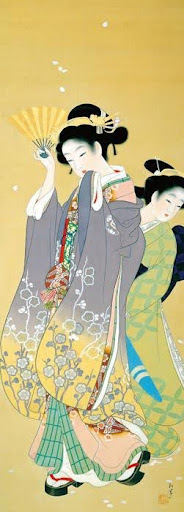2.桜可里(Sakuragari)
春の美学の結晶

《桜可里》(さくらがり)は1914〜1915年頃に制作された季節感と情緒が見事に融合した作品。絵画には華やかな着物に身を包んだ女性と、やや落ち着いた装いの人物が並び立ち、散りばめられた白い花びらは、春の儚さと同時に、女性の美しさを象徴している。前方の女性が扇を持ち、華やかな振袖を纏う一方、奥の人物は抑えた色調の着物を着ており、家庭的な包容力を醸し出している。これは、松園が敬愛する自身の母をイメージソースとして多くの作品を描いた背景とも結びつく。桜は、日本文化において「美」「儚さ」「命の循環」を象徴する花であり、女性の一瞬の輝きと永遠性を対比的に際立たせている。
Sakuragari (Cherry Blossom Viewing)
A crystallization of springtime aesthetics
Created around 1914–1915, Sakuragari is a masterful fusion of seasonal atmosphere and emotional depth. The painting features two women standing side by side—one in a vibrant kimono, holding a fan; the other in more subdued attire. Scattered white petals evoke the fleeting nature of spring while symbolizing feminine beauty.
The contrast between the front figure’s festive furisode and the woman behind her, with her calm presence, suggests a balance between youthful elegance and maternal warmth. This composition reflects Uemura’s deep admiration for her own mother, who frequently served as inspiration in her work.
In Japanese culture, cherry blossoms symbolize beauty, impermanence, and the cycle of life. Through this motif, Uemura contrasts the ephemeral brilliance of womanhood with its enduring strength.
お問い合わせ
〒154-0024 東京都世田谷区三軒茶屋1-39-7